
Amazon isn't the first tech company to pledge to utilize 100% renewable energy—but it's recently made huge strides toward that goal. Every year, more and more companies try to purchase enough renewable energy to match their consumption. Google led the pack as the largest buyer of renewable energy, until they were unseated by Amazon last December. Recently, Amazon unveiled a new energy project that may allow them to achieve total renewable energy by 2025.
When a company pledges to use 100% renewable energy, it means that they aim to offset their energy consumption by purchasing power from renewable sources, like solar or wind. They usually purchase renewable energy from the same grids that power their offices, factories, and other facilities, but this can get a little confusing. That's where instruments called Renewable Energy Certificates (RECs) come in.
When a wind farm and a coal plant pump electricity into the power grid, there's no marker for whose homes or businesses get wind electricity, and who gets coal. So, RECs are used to account for the power produced by the wind farm. When a company purchases RECs, it allows them to claim that they are using renewable energy.
This doesn't necessarily mean that Amazon, Google, and other facilities are powered completely by renewables—since both solar and wind provide electricity only when conditions are favorable, they still need a way to keep the lights on when those power sources fall short. Some renewables are more consistent, but sources like biomass or geothermal power still face obstacles to widespread use.
That's one advantage that power sources like coal or gas have over renewables: They're storable. If a power plant has more coal than it needs at one time, it can hold onto it. This is why the renewable energy industry is dedicated to creating a way of keeping clean electricity long-term. That way, on sunny or windy days when solar panels and turbines produce more energy than is needed, that power can be saved for times when sunlight and wind are in short supply.
In line with its pledge to use 100% renewable energy by 2030, Amazon recently invested in large offshore wind farm off of the coast of the Netherlands. In addition to investing in the farm itself, they will also be purchasing half of its power capacity once it goes online in 2023. It's forecast that it will be able to produce as much as 3.3 TWh a year, or enough wind power for over one million homes.
This wind farm is going to be doing more than just producing electricity, too—it will also explore novel technology for storing renewable power. One of its most promising avenues of research is green hydrogen.
Hydrogen is a great power source. It's a zero-emission fuel that can be used in everything from industrial fuel cells to cars. The only problem is producing the hydrogen in the first place. Right now, this is primarily achieved using fossil fuels, but could be handled by renewables through electrolysis.
In this context, electrolysis is the process of splitting water into hydrogen and oxygen using electricity. The electrical power source is connected to two electrodes, one positive and one negative. When electricity runs through these electrodes, the water “splits,” allowing hydrogen to accumulate at the positive electrode, and oxygen at the negative electrode. Interestingly, pure water isn't very good for this—it needs an electrolyte, like salt, to really help the reaction along. An offshore wind facility would be the ideal place to test out green hydrogen production using electrolysis. Excess wind power that isn't used by homes or businesses could be directed to producing hydrogen from salt water, which could be stored until it's needed for backup power. It's an idea that has a lot of potential, but still requires further research.
In addition to pushing for 100% renewable energy by 2030, Amazon also hopes to be carbon-neutral by 2040. This project places Amazon as much as five years closer to its renewable power goal, but that isn't its most exciting part. If this offshore wind farm successfully furthers research into storing power, it will effectively eliminate the one advantage conventional electricity has over clean energy. Technology like green hydrogen could allow plants to store their excess electricity, removing the need for backup sources like coal or nuclear power.